Grant's Gear Pages
Page 2: Effects & Recording
DOD Analog Delay 680
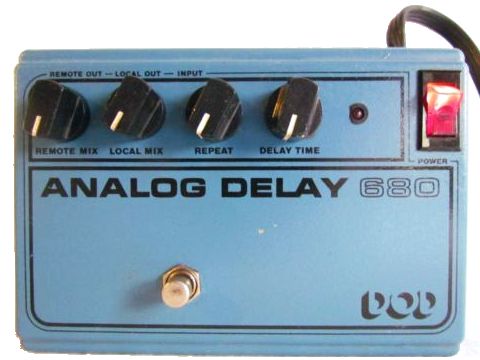
A very nice analogue delay, with stereo output, courtesy of the 'Local' and 'Remote' outputs and mix knobs. Mains
powered and built like a tank in a very robust steel case.
As with all analogue delays, this added nice colouration which became more pronounced with every repeat. Like many
people, I was taken in by the '80s hype that "digital was the future" and so I 'upgraded' to a Yamaha digital delay
pedal later on. This proved to be frustrating when it gave you a clinical repeat of what you fed into it, rather than
a morphing cavern of analogue warmth.
Yamaha DDS-20M Digital Delay Sampler
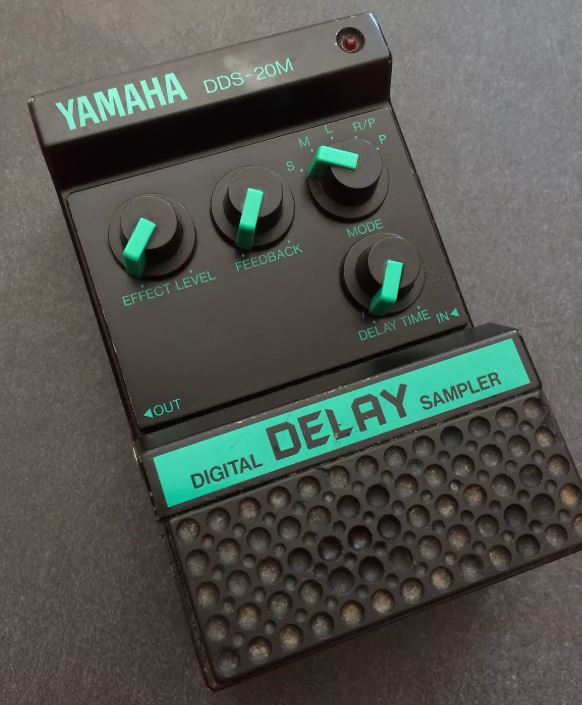
Despite my moans about the clinical nature of digital delays, this pedal had a few neat tricks up its sleeve. Its max
delay time was something crazy like 2 seconds. Not quite enough to do Frippertronics, but you could do elementary
sorts of loop building, decades before that became 'a thing'. You could pause whatever happened to be in the memory and
trigger it as a sample whenever you pressed the pedal. Pitch shifting was possible in real time by turning the delay
time knob. Trying to make this 'musical' was a bit hit and miss, but it was perfectly serviceable for Hawkwind or
Sigue Sigue Sputnik impressions.
Boss DE-200 Digital Delay

One of the most frustrating aspects of the DDS-20M was that it didn't have a 'delayed signal only' (100% wet) output. This is
necessary for Berlin School sequences that bounce around the stereo field, or for those Jean Michel Jarre sweeping
effects, which seem to auto-pan.
This unit has loads of sophisticated features, like modulation, hold, tap tempo, and triggered replay of a sample. I'm ashamed
to say that I only ever used it as a straightforward delay unit, but it performed in that role splendidly.
Yamaha REX50 Multi Effects
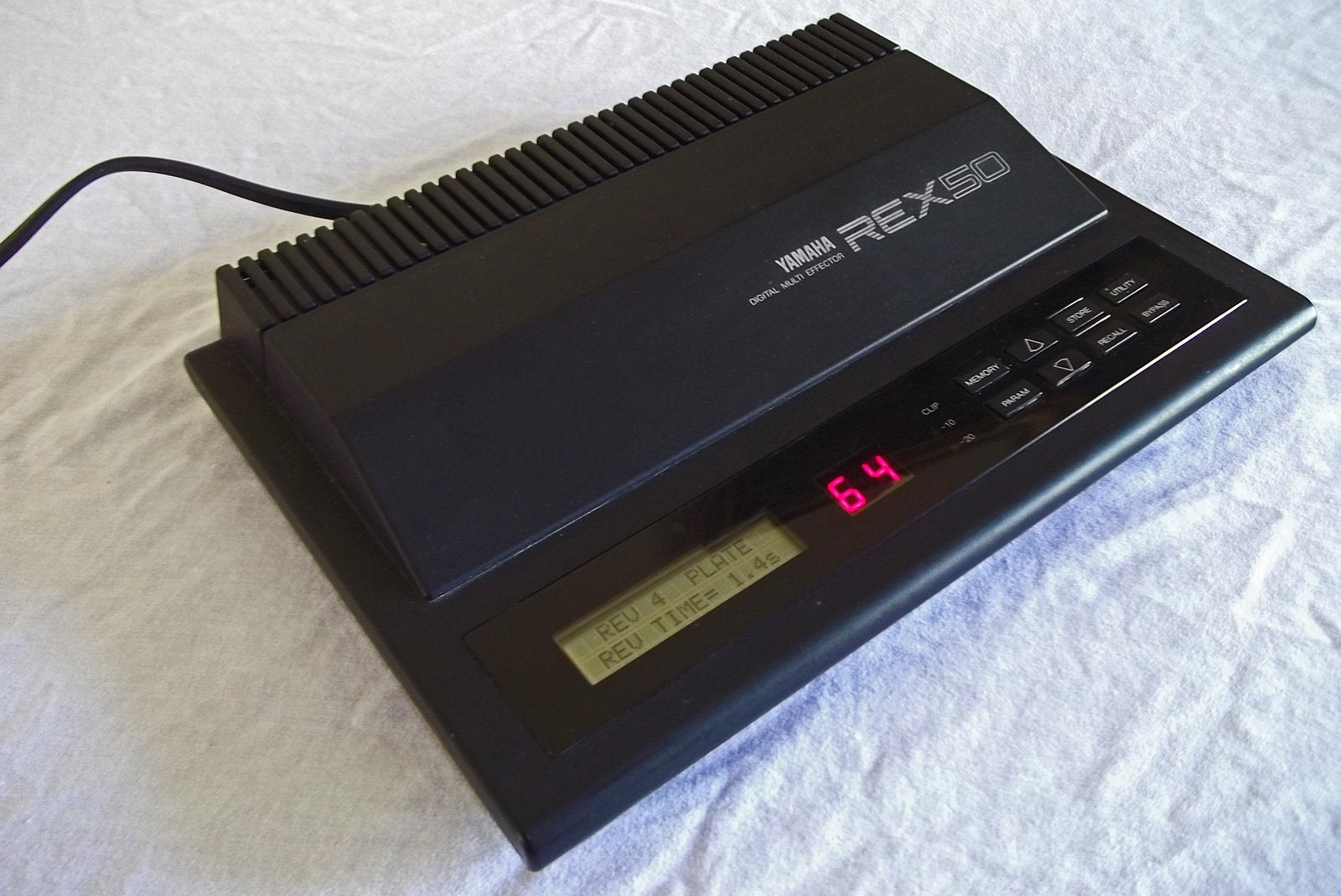
I had had a play about with a Yamaha SPX90 at a music fair in Glasgow. I was very impressed by the selection
of high-quality sounds (for the time). It was a bit out of my price range, however. Fast forward a few years,
and I saw an advert (in the Evening Times again!) for a REX50. I knew from the music mags that this had a
pretty much identical spec to the SPX90, but in a more compact, floor-standing form factor. So I snapped it
up (for £180, if memory serves). It is a very, very versatile little machine. As well as the expected effects,
such as reverb and delay, there were some interesting additions lurking behind the scenes. Most useful for me
at the time was a distortion unit, which could be combined with some of the reverb, delay and modulation effects.
This was a great way of getting Jan Hammer type guitar sounds from the ESQ-1. There was also a 'Symphonic' chorus
effect which was very similar to the Solina ensemble sound. There's a good example of this sound on the track
'Hell', where it forms part of the vocoder choir patch heard at the start of the first sequencer part. The Edge
used the Symphonic effect on "In God's Country", too. A great effects unit, which I would gladly still use today.
Yamaha SPX90 Multi Effects
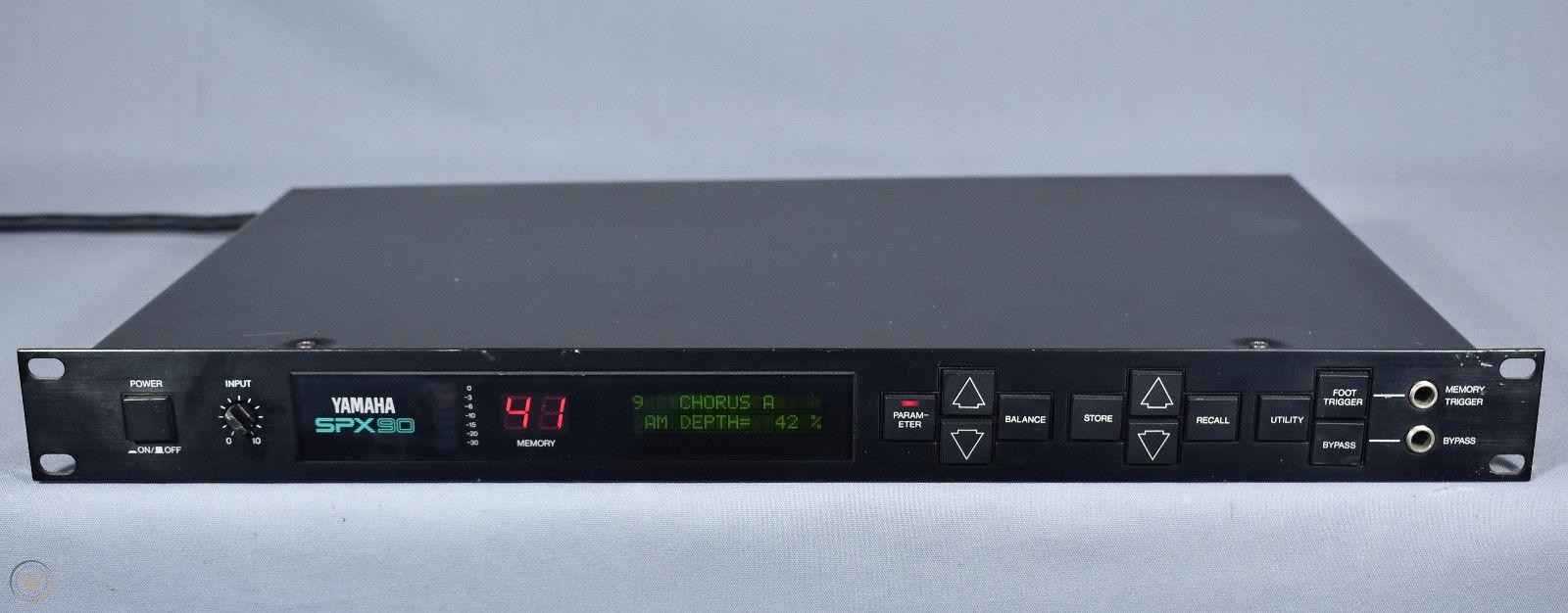
By the time Under the Dome were asked to play live shows, I had sold a lot of my original gear, including the
REX50. So I saw an advert in Sound on Sound for an SPX90, and went ahead and bought it. I was pretty disappointed
to note that the SPX90 didn't have the distortion sounds available. However, my main reason for owning it was
not for recording, but to provide effects for live use (stereo delay 99% of the time). I still have it now,
but it's really starting to show its age. Not so much in cosmetic terms, but simply the quality of the effects
algorithms. I suspect that they were max-ing out the DSP for a lot of the algorithms, and there wasn't much in
the way of RAM for long delays, never mind looping, etc. A few people still like the SPX90, including Dave
Gilmour and The Edge, so what do I know?
Fostex X-26 Cassette Multitracker
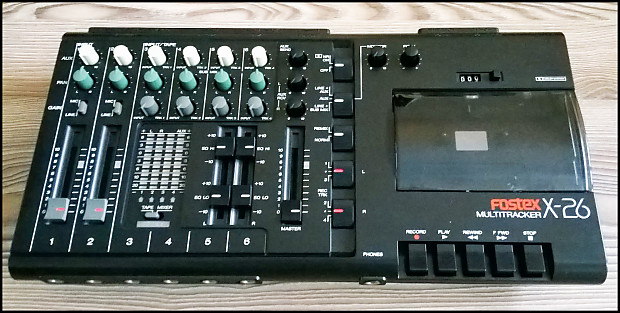
From an early age, I have always had a fascination with recording in general, and with multi-track recording
in particular. My first experience of doing multi-track recording was by doing bounces using a mono cassette
recorder and a hi-fi separate stereo cassette deck. The first 'real' multitrack recorder I ever encountered
though, was a Fostex X-15, owned by David McGibbon. The track "Half A Lifetime" on Dome Roots Collection was
recorded on his machine. From that point onwards, I was determined to own one for myself. Sean Webster had
a Yamaha MT2X and we made quite a few recordings of short songs on it, and I had been through the process of
hiring local 8-track studios to record some of our band's compositions "professionally". The take-away from
all this experience was that I NEEDED to have a multi-tracker of some form for my own exclusive use.
I saved up a few hundred pounds after starting my first job, and after having splurged on various musical items, as
well as paying a deposit on my first house! As luck would have it, Fostex had just recently launched the X-26,
and reading reviews showed me that it ticked all my personal boxes at that stage in time. If memory serves, I
bought it from Sound Control in Jamaica Street. Almost as soon as I got it home, I started experimenting with
recording some of my own music. The first 'proper' long-form piece (The Aeon's Day) was recorded in January of
1990, with Hell being recorded in the summer of that year.
The sound quality wasn't professional by any stretch of the imagination, but it was decent enough to record
the very flat dynamics of synths. Frequency response stopped around about 12kHz, so the top end of resonant
sounds tended to cause a kind of 'aliasing' ring-mod effect. Most of the time this was masked during mixdown
and may, in fact, have contributed a certain 'analogue' quality to the recordings. Tape speed was 'normal'
only (i.e. 1 7/8 inch per second), while a lot of multitrackers at that time offered x2 speed as an option
(or even 'always on'). Noise reduction was Dolby B, which I found worked better than DBX for recording synth
music.
The main thing though, was that it gave me the freedom to experiment with real studio techniques and to capture
the ideas that I had been jamming around with over the previous months in my own wee house.
M-Audio M-Box Audio Interface

Before talking about the M-Box specifically, I need to take a detour back to the time when I worked in the audio
department of DMA Design. When I arrived there in mid-1995, the audio department were at the early stages of
figuring out what form the in-game music would take on the very first version of Grand Theft Auto. After a bit
of discussion, it was decided that there would be a series of different 'radio stations', which would play
on the car stereo when you entered a vehicle. It was also decided that we would try our best to make all the
songs and DJ voiceovers as authentic as possible, so we would require some form of professional audio recording
system (instead of previous games which used MIDI-driven chip music). So, off we trundled to
Mediaspec in
East Kilbride to check out the state of the art - a Pro-Tools III Hard-Disk based system. I don't think I've
ever experienced such techno-lust in my entire life - it was my dream recording environment. In fact, I hadn't
even considered how perfect a non-linear disk-based system could be, compared to all the tape-based systems
I had used previously. Anyhow, we managed to persuade The Big Cheese at DMA (Dave Jones) that it would be
a huge benefit to the audio department to buy a Pro-Tools system, especially for the development of GTA.
Now, it didn't take me long to realise that it would be possible to transfer my old multi-track cassette tapes
onto Pro-Tools, and use all the processing tools to remaster them for CD pressing (or at least, CD-R writing).
And so, during evenings and weekends, and during my time in Devil's Thumb Games in Boulder, CO, I was able
to fully remix and remaster The Aeon's Day, Hell and The Bridge. I also performed remastering on the 2-track
stereo mixdowns for many other tracks. DINR (Digidesign
Intelligent Noise Reduction) was an incredible plug-in
for reducing the tape noise effectively to silence, with minimal impact on the desired recorded audio. I also
had access to Lexicon reverbs in the form of the Nuverb card in Dundee and a PCM 90 rack in Boulder.
Fast-Forward to 1998, when I was back working at Marconi after having left DMA. Under the Dome were signed to
Neu Harmony records, and The Demon Haunted World had been released during the summer. Dave Law was making noises
about us starting to record a follow-up. Now, I didn't have access to Pro-Tools any more (although Colin did),
but I downloaded the demo of a PC-based recording system called n-Track Studio. This formed the basis of most
of my recording from '98 onwards.
Fast-Forward again to 2005. I was due to play a two-set concert at the National Space Centre in Leicester, but
whichever way I looked at it, it soon became obvious that in order to play two hour-long sets of continuous
music, I was going to have to rely on a backing track, at least to provide short bridges between tracks which
would be performed completely live. It was a bit of a compromise after having played completely live at Hampshire
Jam 2, NSC 2003, and The Gatherings and Star's End in Philadelphia. Still, it seemed the only solution. I realised
that in order to do a good job on the backing, I would require a better audio interface for my PC. As luck
would have it, my local music shop, Kenny's Music in Dunfermline, were having a clearance sale on their stock
of M-Audio M-Boxes, as the version 2 was coming out soon. The M-Box hardware came bundled with Pro-Tools LE,
and I soon felt right at home again.
It's a really great piece of hardware, capable of 24-bit stereo recording (with some really nice input channels).
Unfortunately, once Microsoft started releasing post-XP versions of Windows, the M-Box and its drivers became
incompatible, rendering the hardware obsolete and unusable. I ended up buying an old XP machine from work and
giving it, and the M-Box to my nephew Craig, as he was starting to get interested in music and recording at that
time.
Behringer UMC404 HD Audio / MIDI Interface

I wanted to make a transfer of my old four-track cassettes into the digital domain in time for the 30th
anniversary of laying down The Aeon's Day. Fortunately, I was helping David McGibbon move house at the
time, and was looking after his Fostex X-26 for a couple of months. It turns out that this was actually
my machine, which I'd sold to Dave in the early '90s. Anyhow, I needed some method of recording all four
tracks simultaneously as they played back on the X-26. Initially, I was going to use Colin's Behringer
mixer and Reason, but unfortunately, his mixer died. I decided that it was time for me to start looking
for a new recording setup for myself. The Behringer UMC404 seemed to fit the bill perfectly and was
getting great reviews. So I bought it for myself. Fortunately, it came bundled with a free version of
Tracktion's Waveform 8 software, which allowed recording on four tracks simultaneously (unlike Audacity,
which could only manage stereo recording).
Sound quality is fantastic, and it allows up to 24-bit 192kHz recording. It also has a MIDI interface
built in, which can handle the Nord Modular editor, thankfully.
To be continued...
E-Mail Grant







